A St Bernard Great Pyrenees mix is a cross between a St Bernard and a Great Pyrenees.
These two breeds are very different, so it’s important to know what to expect if you’re thinking of getting one of these mixes.
Here are 17 things you should know about them before taking the big step of owning one.
St Bernard Great Pyrenees Mix – Breeding History
St. Bernard
The St. Bernard is a large working dog breed originally bred for rescue by the hospice of the Great St. Bernard Pass on the Italian-Swiss border. They were not recognized as an official breed until 1880.
In 1988, the Swiss Kennel Club recognized the Greater Swiss Mountain Dog as a distinct breed.
Prior to this time, all four varieties were considered one breed and registered under three names: short-haired Saint Bernards in Switzerland, long-haired Saint Bernards in France and Germany, and both short- and long-haired in England and America.
The most likely ancestor of the St. Bernard is the Alpine Mastiff, a large working dog used for herding and guarding livestock as well as for personal protection, drawing carts, and avalanche rescue.
These dogs were brought to Switzerland by Roman troops in the first century AD. The St Bernard is a gentle, patient, solid dog. It is strong, powerful, and athletic, with a good nature and friendly disposition.
Great Pyrenees
The Great Pyrenees is a dog breed that has been around for centuries. The breed is thought to have originated in Asia and then made its way to Europe.
They were first bred in France, and the breed quickly became popular among the French aristocracy. The Great Pyrenees continued to be popular in Europe for many years and eventually made their way to America.
The Great Pyr is now a popular breed in both America and Europe. The combination of these two powerful breeds is sure to give you a dog that is both fearless and protective.
You may also like – Komondor Great Pyrenees Mix – Here’s What to Expect
St Bernard Great Pyrenees Mix – Physical Features
The Bernard Great Pyrenees mix is a large and powerful dog with a muscular body and a thick coat. The head is large and round, with a short muzzle. The eyes are dark and expressive.
The ears are floppy and hang down close to the head. The tail is long and thick and may be curved or straight.
The coat of the Bernard Great Pyrenees mix is dense and thick, making the dog appear even larger than it already is.
The coat may be any color but is most commonly white with brown or black markings. This breed sheds heavily, so regular brushing is necessary to keep the coat clean and free of tangles.
Temperament of a St Bernard Great Pyrenees Mix
The St. Bernard Great Pyrenees mix is a giant, fluffy, and lovable dog breed. They are known for being gentle giants and are great with children and other pets.
They are loyal and protective of their family and make excellent watchdogs. Although they are not the most active dog breed, they do need daily exercise to stay healthy and happy.
If you are looking for a big, cuddly, and loving companion, the St. Bernard Great Pyrenees mix may be the perfect dog for you!
St Bernard Great Pyrenees Mix – Training Needs
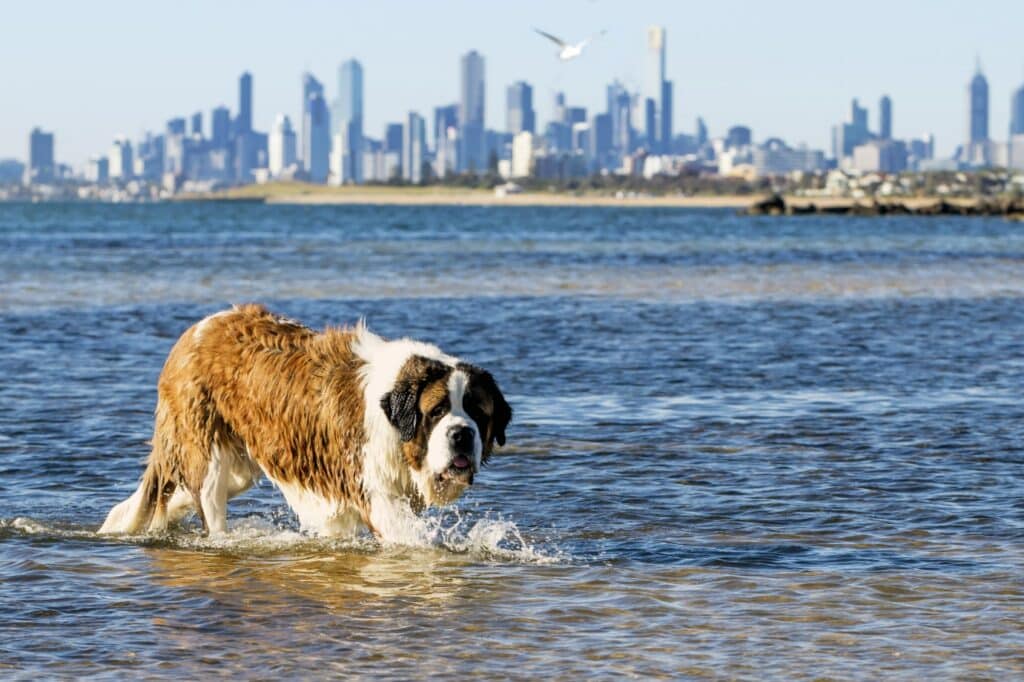
A St. Bernard-Great Pyrenees mix is a large, loyal dog that will make a great addition to any family.
However, potential owners should be aware that this breed requires a lot of time and effort when it comes to training.
Potty Training
Potty training any dog can be difficult, but potty training a St. Bernard Great Pyrenees mix can be especially challenging.
This large breed of dog is known for being stubborn, and it can be very resistant to change. However, with patience and consistency, you can successfully potty train your St. Bernard Great Pyrenees mix.
The first step in potty training your St. Bernard Great Pyrenees mix is to choose a designated area for them to go to the bathroom. This could be a specific spot in the yard or a spot on a newspaper indoors.
Once you have chosen a designated area, take your dog to that spot regularly and give them plenty of time to sniff around and do their business.
If your St. Bernard Great Pyrenees mix does not immediately relieve itself when taken to the designated area, do not get discouraged. Some dogs may require more time and patience.
This is the time to give your St. Bernard Great Pyrenees mix a treat. If you do this every time they go to the bathroom in their designated area, they will quickly learn that going to that area means they will receive a reward.
Obedience Training
Like all dogs, the St. Bernard-Great Pyrenees mix needs basic obedience training. This includes commands such as sit, stay, come, down, and heel.
Due to their size and strength, it is especially important to start obedience training early on with this breed. Registering your puppy in the local puppy obedience classes is a great investment and will also help with getting your puppy used to other dogs.
Socialization
In addition to obedience training, socialization is also key for the St. Bernard-Great Pyrenees mix.
This means exposing them to different people, places, and situations at an early age, so they grow up to be well-rounded dogs. Without socialization, they can become fearful or even aggressive as adults.
St Bernard Great Pyrenees Mix – Exercise Needs
A St Bernard Great Pyrenees mix is a large, friendly dog that needs plenty of exercise. The parents of this mixed breed are known for their size and gentle dispositions.
As a result, the St Bernard Great Pyrenees mix inherits some of the best qualities of both the St Bernard and the Great Pyrenees.
These dogs are intelligent and eager to please, making them great family pets. They are also very social creatures that enjoy being around people and other dogs.
However, because of their size and energy levels, Bernard Great Pyrenees mixes need plenty of activity to remain healthy and well-behaved.
Daily Walk
A daily walk is a simple way to help your dog burn off some energy and stay healthy.
Here are a few things to keep in mind when walking your St. Bernard Great Pyrenees mix:
1. Start out slowly – don’t try to go too far or too fast on your first walk. Your dog needs time to get used to the exercise.
2. Bring plenty of water – your dog will need to drink lots of water after the walk, so make sure you have enough for both of you.
3. Be prepared for potty breaks – since your dog will be drinking lots of water, he may need to stop for frequent potty breaks. Be patient and keep an eye out for signs that he needs to go.
Running
The St. Bernard Great Pyrenees mix is a large, powerful dog with an impressive stride. Though they are built for endurance, they can benefit from some extra running exercise to stay in shape.
Just like any other breed of dog, they need to be properly trained and supervised while running to avoid injury.
Here are a few tips to get you started:
1. Start slow and gradually increase their running distance and speed as they build up their endurance.
2. Take them on a variety of different running routes, so they don’t get bored.
3. Be sure to provide plenty of water breaks along the way and monitor them closely for signs of heat exhaustion or dehydration.
4. Avoid running in extreme weather conditions, either too hot or too cold, to protect your dog’s health.
Hiking
Hiking is a great way to get your St. Bernard Great Pyrenees Mix in shape. It is important to start slowly and build up the distance and difficulty of the hike as your dog gets used to it.
Remember to bring plenty of water and snacks for both of you, and take breaks often. Hiking is a great way to bond with your dog while getting some exercise, so get out there and enjoy the trails!
Swimming
Swimming is a great way to get your St. Bernard Great Pyrenees mix the exercise they need while having fun at the same time.
Here are some tips for swimming with your St. Bernard Great Pyrenees mix:
-Take them to a quiet spot where they can get used to the water at their own pace
-Start with short swims and gradually increase the distance as they get more comfortable
-Make sure they have a life jacket or floatation device that fits properly
-Be patient and keep it fun – remember that not all dogs are natural swimmers!
St Bernard Great Pyrenees Mix – Mental Stimulation
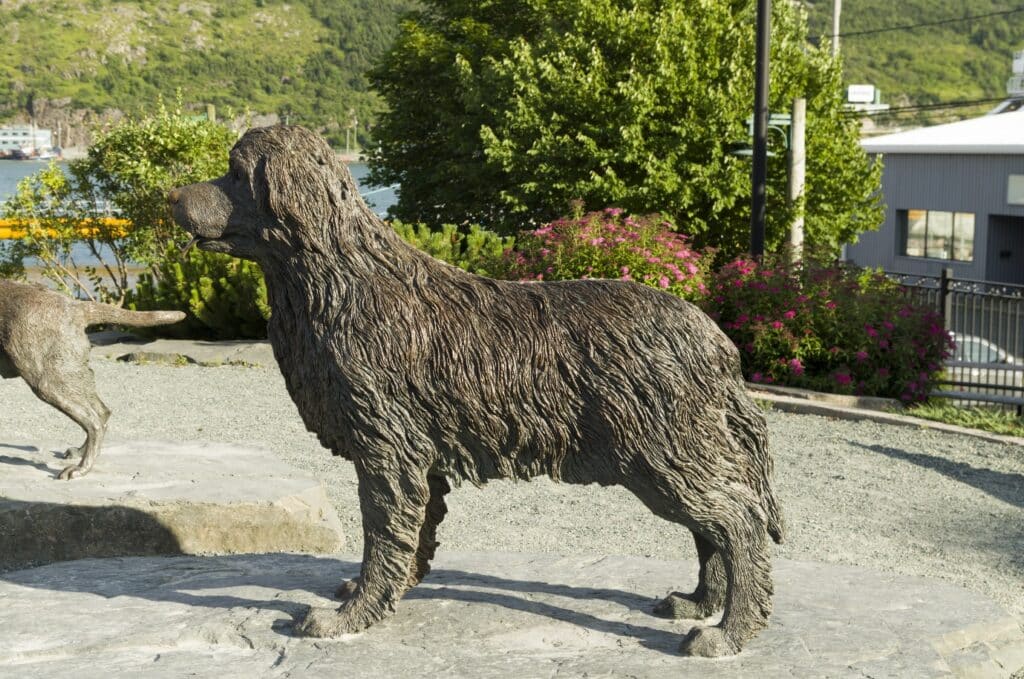
The Saint Bernard Great Pyrenees mix is a unique and intelligent breed of dog. They are highly trainable and excel in obedience, making them great family pets.
However, they need plenty of mental stimulation to stay happy and healthy. Without proper enrichment, they can become bored and destructive.
Here are some ideas for mentally stimulating your Saint Bernard Great Pyrenees mix:
-Interactive Toys: food puzzles or Kongs stuffed with treats are a great way to keep your dog’s brain challenged.
–Training Sessions: daily training sessions will not only help tire your dog out physically but also give them a chance to use their brains.
– Walks/Runs: change up your walking route regularly to keep your dog’s interest piqued. Add in some short training sessions during your walk for an extra mental challenge.
–Playing Fetch: toss a ball and let your dog chase after it. If they bring it back, give them a treat or praise to acknowledge their success.
–Foraging: hide treats around your house during the day and let your dog find them. This will not only be mentally stimulating for your dog but also help with their problem-solving skills.
–Teach Your Dog Tricks: teach your dog some tricks like “lay down” or “rollover”.
St Bernard Great Pyrenees Mix – Grooming
They do require a lot of grooming, however, as they have long hair that can easily become matted. Daily brushing is essential, as well as regular baths.
If you are prepared to commit to the grooming requirements of this breed, you will be rewarded with a loyal, affectionate companion.
Bathing
While the St. Bernard Great Pyrenees mix is a beautiful, majestic dog, it can be quite difficult to bathe.
Here are some tips on how to make bathing your St. Bernard Great Pyrenees mix a bit easier.
First, it is important to find a large enough tub or pool that your dog can comfortably fit in. You may need to purchase a special dog bathtub or small swimming pool just for them.
Second, use a mild shampoo designed specifically for dogs to avoid irritating their skin.
Third, make sure you rinse all of the soap out of their fur completely before drying them off with a towel.
Fourth, it is best to brush their fur while it is still wet to avoid mats and tangles.
Brushing
A good brushing routine is important for any dog, but especially for a St. Bernard Great Pyrenees mix.
This breed is known for its thick, double coat, which can become matted and tangled if not brushed regularly. Brushing not only helps keep the coat healthy and free of knots, but it also helps to remove any dirt or debris that may be caught in the fur.
To brush your St. Bernard Great Pyrenees mix properly, you will need a few supplies: a quality dog brush, a wide-toothed comb, and some patience! Start by brushing the dog’s back and sides with the brush, working your way down to the legs.
Be sure to pay special attention to any areas that tend to mat easily, such as the neck and behind the ears.
Ears
The St. Bernard Great Pyrenees mix needs its ears cleaned on a regular basis to prevent infection.
Here’s how to clean your dog’s ears:
First, lift your dog’s ear up and look inside. You should see a small amount of wax buildup near the opening of the ear canal.
If you see a lot of wax or if the ear seems red or inflamed, it’s time to take your dog to the vet for a professional cleaning.
If the ear looks healthy, you can clean it at home using a cotton ball dipped in warm water.
Gently wipe away any wax buildup, being careful not to push too far into the ear canal. Once the ear is clean, dry it off with a soft towel.
Teeth
Dogs are known for their love of food. But what about their teeth? Just like humans, dogs need to take care of their teeth, or they can run into some big problems down the road.
Poor dental hygiene can lead to gum disease, tooth loss, and even heart disease. So, how do you brush your dog’s teeth?
The first step is to find a toothbrush that is the right size for your dog’s mouth. You may also want to consider using a finger brush or a piece of gauze wrapped around your finger.
Next, choose a pet-safe toothpaste. There are many flavors available, so find one that your dog will like.
To brush your dog’s teeth, start by lifting up their lip and gently rubbing the bristles along the gum line. Be sure to brush each tooth, including the back teeth.
This can be difficult if your dog isn’t used to having their teeth brushed. You may need to use treats as an incentive at first.
Is the St Bernard Great Pyrenees Mix suited for People with Allergies?
Firstly, it’s important to realize that no dog is truly hypoallergenic. Allergies are caused by proteins in a dog’s saliva and dander, which are dead skin cells.
Even “hypoallergenic” dogs can still cause an allergic reaction in some people. Now that we have that out of the way let s get to the good news. St Bernard Great Pyrenees mixes are known for being very low-shedding dogs.
This means you can own one without worrying about a lot of long dog hair around the house. It also means the dog will produce less dander and saliva, which can help reduce allergies.
If you are still concerned about allergies, consider taking these precautions:
- Bathe your dog regularly. This helps get rid of dead skin cells that cause allergies. Consider using dog shampoo with oatmeal.
- Wash the dog’s bedding and toys regularly. This helps reduce dander and saliva from getting into your house.
- Vacuum your house frequently. This will help remove dander and saliva from carpets and couches. Consider using an air purifier in your home to reduce allergens.
St Bernard Great Pyrenees Mix – Health Conditions
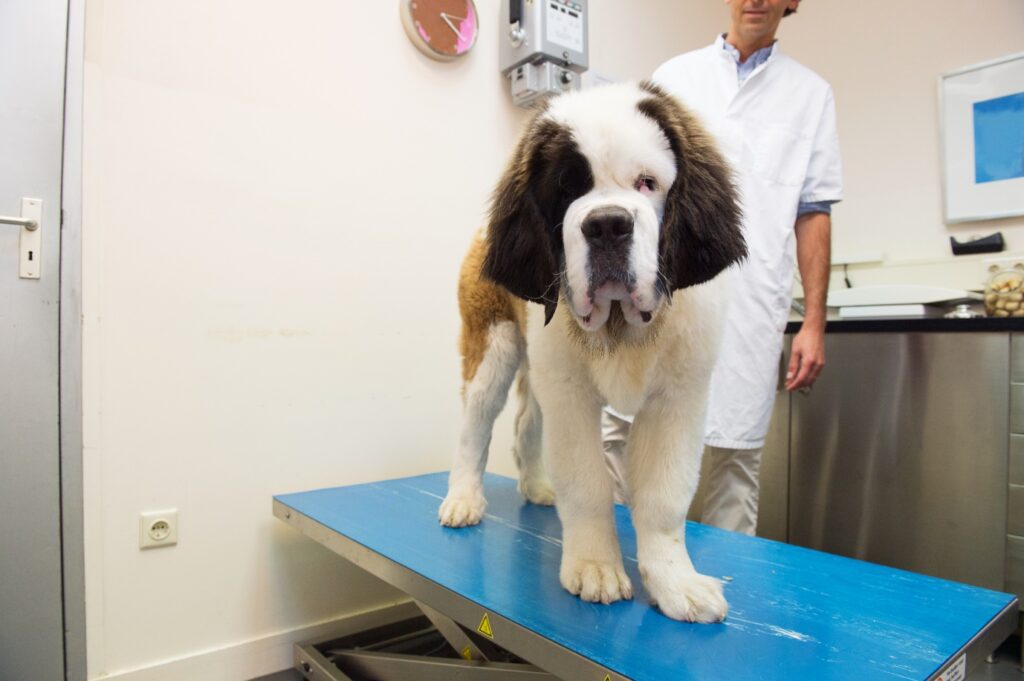
This mixed breed has many different health conditions that can affect them. Some of the more common health problems include:
Hip Dysplasia
Hip dysplasia is a condition that can affect any dog, but some breeds are more prone to it than others. The St. Bernard Great Pyrenees mix is one of those breeds.
Hip dysplasia occurs when the hip joint doesn’t develop properly. This can lead to pain and lameness in the affected dog. It’s a hereditary condition, so it’s important to get your dog from a reputable breeder who has health-tested their dogs for hip dysplasia.
There’s no cure for hip dysplasia, but there are treatments that can help manage the pain and keep your dog comfortable. If you think your dog may have hip dysplasia, talk to your vet about treatment options.
Elbow Dysplasia
Elbow Dysplasia is a common condition in large-breed dogs. It occurs when the bones in the elbow joint do not form properly. This can cause pain, lameness, and arthritis.
Elbow Dysplasia is most common in large breed dogs, such as the St. Bernard Great Pyrenees mix. The condition is congenital, which means it is present at birth.
The most common symptom of Elbow Dysplasia is lameness in the front leg. This is usually first noticed when the dog is young, between four and six months old.
Other symptoms include pain and swelling in the elbow joint, stiffness, and decreased range of motion.
Bloat
Bloat is a condition that can affect any dog, but it is especially common in large-breed dogs. The St. Bernard Great Pyrenees mix is no exception. Bloat occurs when the stomach fills with gas and twists, trapping the gas inside.
This can cause the stomach to rupture and be fatal if not treated immediately. Several things can contribute to bloat in dogs, including eating too much, drinking too much water before or after exercise, and eating from raised food bowls.
Some dog breeds are more prone to bloat than others, and the St. Bernard Great Pyrenees mix is one of them.
There are some simple steps you can take to help prevent bloat in your dog.
Step 1 Provide your dog with a raised feeding bowl. This will allow him to eat and drink without gulping down too much air at once. A good height is about 2 inches higher than the dog’s back.
Step 2 Make sure your dog is not over-eating. A St. Bernard Great Pyrenees mix should be fed about 1 cup of dry food per 20 pounds of body weight each day. If you have a very active dog, feed him a little more.
Step 3 Feed your dog several small meals throughout the day rather than one large meal.
Step 4 Don’t let your dog exercise after eating a large meal. Give him at least 2-3 hours to digest his food before he exerts himself.
Step 5 Get your dog checked for tracheal collapse. A condition common in large-breed dogs, this ailment can cause breathing difficulties and death if it is not treated.
Other health issues that have been known to affect this type of dog include allergies, skin problems, and eye problems.
St Bernard Great Pyrenees Mix – Nutrition
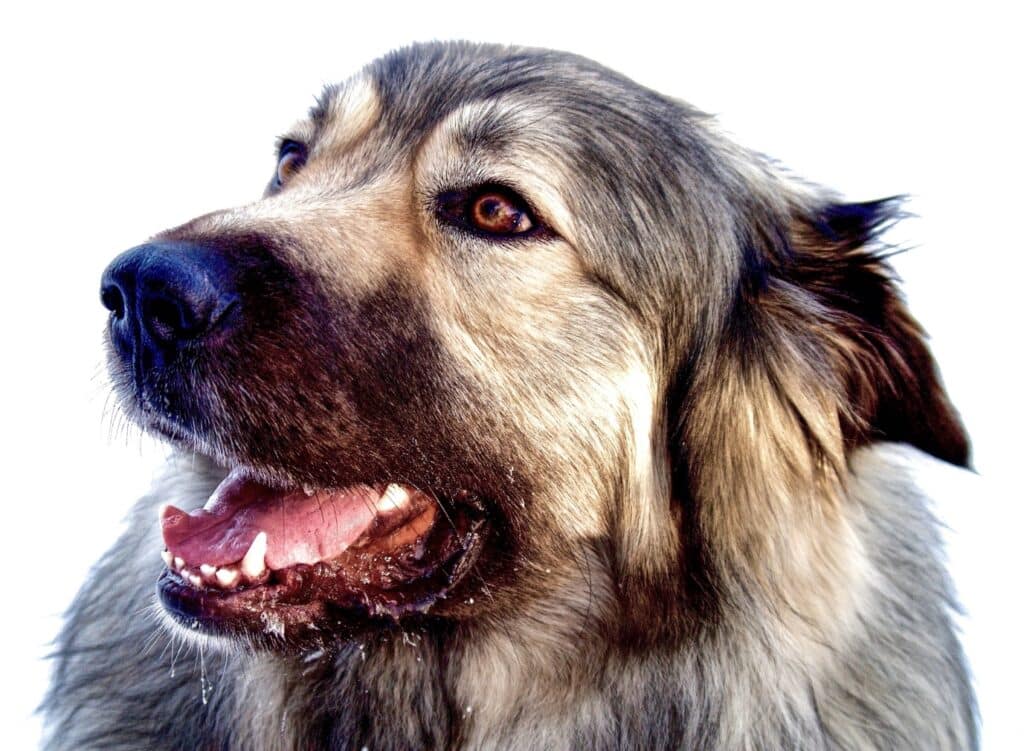
As the St Bernard Great Pyrenees mix is a large and powerful dog, they require a lot of food to maintain their energy levels. This means that they require a higher quality and quantity of food than other smaller breeds.
This mix needs a very high protein diet that helps them build and maintain strong muscles and bones.
“They also require a moderate amount of fat in their diet which helps keep their energy levels up”.
The following meal options are your best bet:
- High-quality puppy food
- Kibble or canned food (with minimal preservatives)
- Protein-rich foods like chicken, turkey, eggs, and salmon. However, they do not have to eat these high-protein foods every day. They do best with a high-quality diet that has a variety of sources. This gives them the protein they need without causing any digestive issues.
- You can also feed them fruits like apples, bananas, and berries. They should not eat any dairy products. This is because they do not have the enzymes needed to digest it properly. It could cause a life-threatening case of bloat.
“Avoid foods that are high in fat. Do not feed them any human food like bread, crackers, or cakes. These can cause serious health problems later on”.
Table Scraps
Feeding table scraps to your St. Bernard Great Pyrenees Mix can be a great way to add some variety to their diet and give them a little treat. However, there are a few things you should keep in mind when doing so.
First, make sure that the food you’re giving them is safe for dogs. Some foods that are fine for humans can be toxic to dogs, so it’s important to do your research before feeding anything new.
Second, don’t overdo it – table scraps should only make up a small part of their diet. Too much human food can lead to weight gain and other health problems.
Finally, be sure to supervise your dog while they’re eating, just in case they decide to scarf down their food too quickly and choke on it.
Supplements
If you have a St. Bernard Great Pyrenees mix, you may be wondering what supplements are best for your pet. Here are a few things to consider when choosing supplements for your St. Bernard Great Pyrenees mix:
1. Consult with your veterinarian to see if any supplements are recommended or necessary for your pet.
2. Take into account your pet’s age, weight, and health condition when selecting supplements. For example, senior dogs may need different supplements than younger, healthier dogs.
3. Choose supplements that are specifically designed for large breed dogs like the St. Bernard Great Pyrenees mix. These supplements will help support your pet’s joints and bones and keep them healthy and strong.
Is the St Bernard Great Pyrenees Mix Dog Friendly?
The answer is yes, for the most part. The Bernard Great Pyrenees mix is a gentle giant that loves nothing more than being around their family. They are patient and loyal, making them great companions for kids.
They also get along well with other dogs and animals, although they may be too rough for smaller pets such as cats or rabbits.
If you’re looking for a big, friendly dog to add to your family, the Bernard Great Pyrenees mix is a great choice.
Is the St Bernard Great Pyrenees Mix Child Friendly?
Yes, the St Bernard Great Pyrenees mix is child friendly. They are gentle giants who are great with kids. They are also patient and protective, which makes them ideal family dogs.
However, they do require a lot of exercise and space, so if you’re looking for a small dog that can live in an apartment, this is not the breed for you.
St Bernard Great Pyrenees Mix – Drooling Levels
The St Bernard Great Pyrenees mix is a large, powerful dog that is known for its high drooling levels.
This mix is not for everyone, as they require a lot of care and attention. If you are considering this mix, be prepared for lots of drool!
“Drooling can be minimized by brushing your dog’s teeth regularly and providing dental chews to keep the teeth healthy”.
St Bernard Great Pyrenees Mix – Barking Levels
When it comes to deciding if a St Bernard Great Pyrenees mix is the right dog for you, one of the most important factors to consider is how much they bark.
While all dogs bark to some extent, some breeds are known for being particularly vocal, and this can be a major downside if you live in an apartment or close quarters.
Generally speaking, these dogs tend to be on the quieter side when compared to other breeds.
They may bark when someone comes to the door or when they are playing fetch, but they are not typically incessant barkers.
If you’re considering getting a St Bernard Great Pyrenees mix, rest assured that you likely won’t have to deal with excessive barking.
St Bernard Great Pyrenees Mix – Cold Weather Tolerance
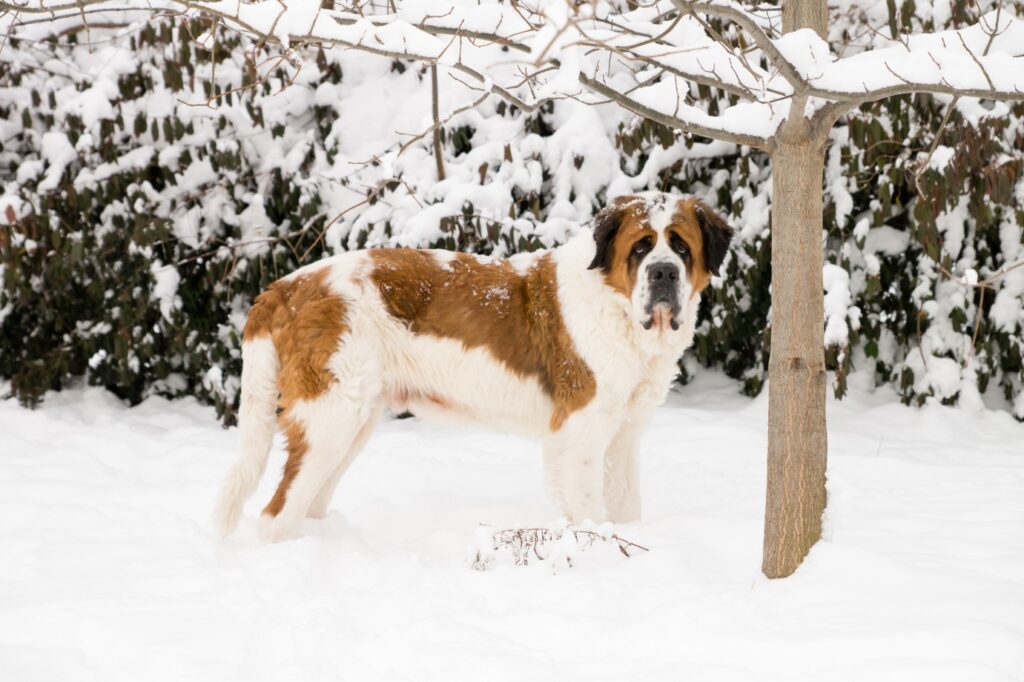
The St Bernard Great Pyrenees mix is a large and powerful dog breed that is known for its cold weather tolerance. Both parent breeds are known for their adaptability in cold weather conditions.
This mixed breed is therefore a great choice for people who live in cold climates or who enjoy spending time outdoors in cold weather. The mix has a thick coat of fur that helps to protect it from the cold and keep it warm.
The St Bernard Great Pyrenees mix is also a very strong and sturdy dog breed, making it well-suited for outdoor activities such as hiking and camping.
St Bernard Great Pyrenees Mix – Life Expectancy
The average life expectancy of a St Bernard Great Pyrenees mix is 8-10 years. This is slightly shorter than the average life expectancy of the purebreds but still within the normal range.
St Bernard Great Pyrenees Mix – Puppy Prices
The price of a St Bernard Great Pyrenees mix puppy will vary depending on the breeder, the location, and the availability.
However, on average, these puppies cost around $600 to $1,200. You can also find cheaper puppies from pet stores and classifieds, but you need to make sure that the parents have been certified for good health.
RECOMMENDED – The Ultimate Great Pyrenees Guide – All Questions Answered!


